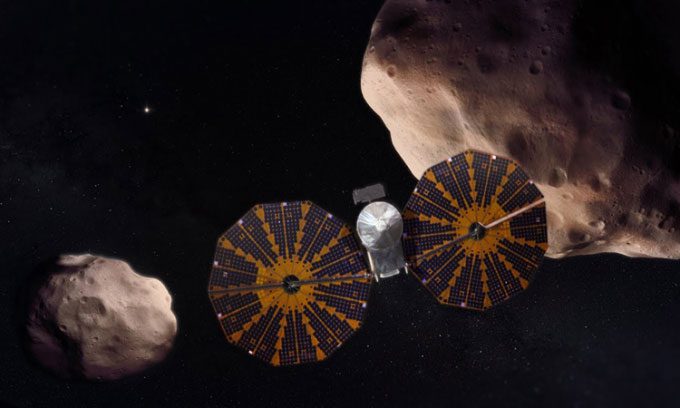NASA’s asteroid probe will begin its 12-year space exploration journey next month, setting several new records.
The Atlas V rocket from United Launch Alliance is scheduled to launch Lucy, NASA’s spacecraft, from Cape Canaveral Space Force Station in Florida on October 16. This launch will kick off Lucy’s special mission to approach and study 8 asteroids over the course of 12 years.

Illustration of the Lucy spacecraft studying asteroids. (Photo: SwRI).
“We are about to visit more asteroids than any spacecraft in history. We will also set another record by flying farther from the Sun than any solar-powered spacecraft in history,” said Hal Levison, a scientist at the Southwest Research Institute (SwRI), during a press conference on September 28.
Lucy’s primary target is the Trojan asteroids – a group of celestial bodies that orbit the Sun in tandem with Jupiter. They are divided into two large clusters, one group ahead of Jupiter and the other behind it.
Lucy’s journey will be long and winding. The spacecraft is expected to perform two flybys around Earth to gain speed before heading towards Jupiter. By April 2025, Lucy will conduct its first flyby of the asteroid (52246) Donaldjohanson in the main asteroid belt of the Solar System. Next, the spacecraft will reach the leading Trojan cluster, flying past 4 asteroids from August 2027 to November 2028. Afterwards, it will move to the trailing cluster to study three asteroids in March 2033.
“Lucy will come within about 1,000 km of the surface of these celestial bodies and will not slow down during its flybys. It will continue moving at speeds of 5 to 8 km per second relative to the Trojan asteroids,” stated Keith Noll, a scientist on the Lucy project at NASA’s Goddard Space Flight Center.
“The approaches happen very quickly, and the best data is collected just a few hours around the closest approach,” Noll added. The data will be collected by Lucy’s various spectrometers and cameras, helping the research team understand more about the composition, structure, and behavior of the asteroids.
The total funding commitment from NASA for Lucy is $981.1 million, according to Lori Glaze, head of NASA’s Planetary Science Division. This funding will support Lucy from the start of the mission until its completion in 2033.





















































